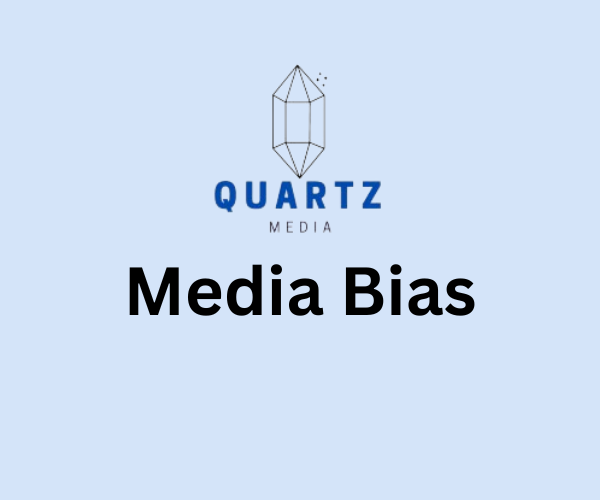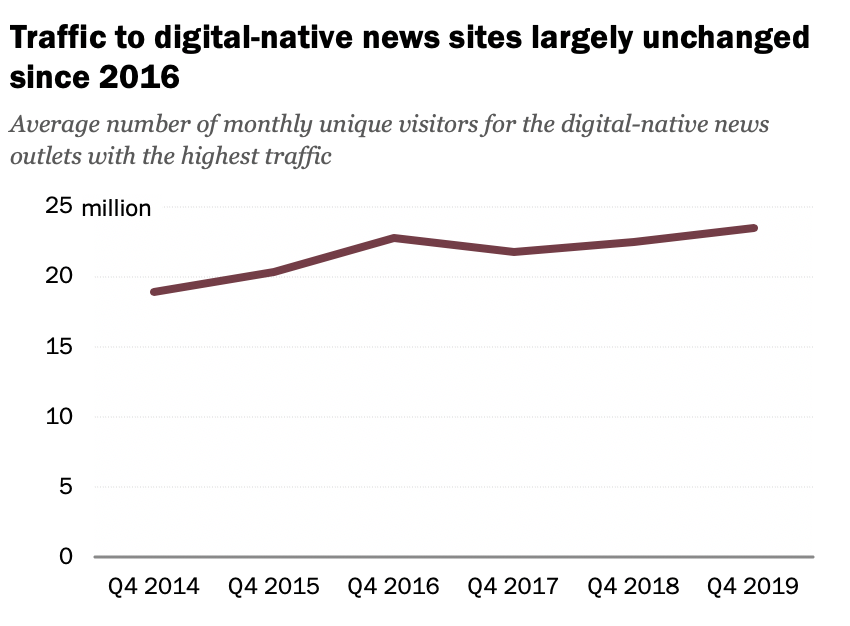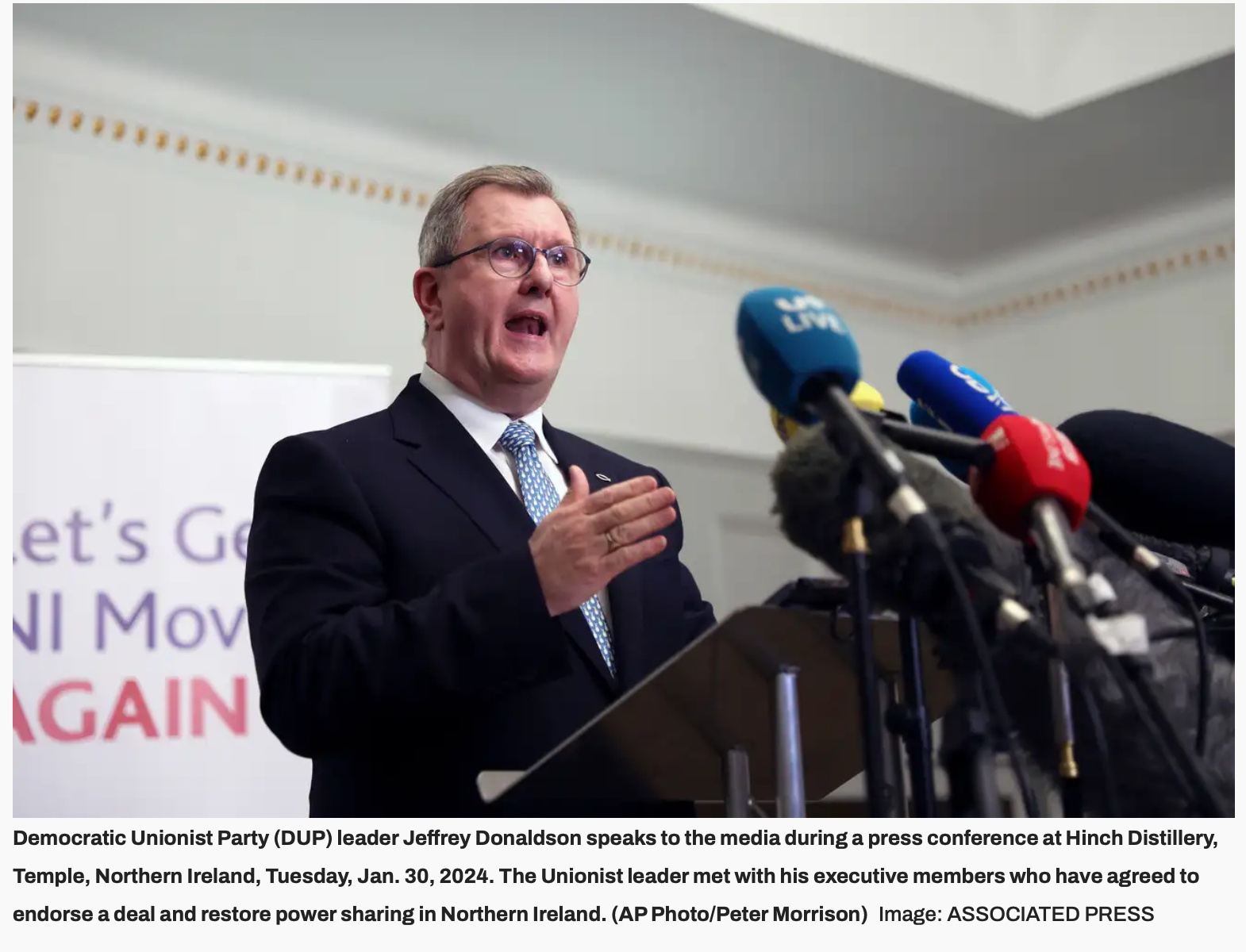
Founded in September 2012, and based out of New York City, Quartz Media’s path has been untraditional compared to some of its competition. From its late entry into the field, to having its own news app, to an eventual dip in sales and buyout by the G/O Media company, Quartz has had a volatile history. Despite this, the organization continues to present news on international business, current events, and the global economy.
Quartz Media is a digital-native news site, meaning their upbringing has been solely online, and has seen up and down ratings. They used to feature a paywall to access content, but dropped it in April of 2022. The Pew Research Center features a graph representing how digital-native news sites garner decent traction that tends to be consistent; however, Quartz Media did not fall into this category.

Source: Pew Research
Quartz has seen a decline in traffic over the past few years, even after dropping their paywall. It is important to observe any bias they carry in their reporting to understand this trend. We will keep potential bias in mind as we analyze articles published by the group.
How Does Biasly Rate News Sources?
Biasly’s algorithms produce bias ratings to help provide multiple perspectives on given articles. Biasly has analyzed 200,000+ news articles from more than 3,200 news sources through our A.I. technology and team of political analysts to find the most factual, unbiased news stories.
Biasly determines the degree of political bias in news sources by using Biasly’s Bias Meter Rating, in which Biasly’s team analyzes media sources’ reliability and bias and produces three scores, a Reliability Score that measures the accuracy of media sources; an A.I. Bias Score, evaluated by A.I.; and an Analyst Bias Score evaluated by political analysts. These scores are rated based on seven rating metrics including Tone, Tendency, Diction, Author Check, Selection/Omission, Expediency Bias, and Accuracy. These metrics help our analysts to determine the political attitude of the article.
Our A.I. machine-learning system employs natural language processing and entity-specific sentiment analysis to examine individual articles and determine their bias levels. By analyzing the key terms in an article such as policies, bias phrases, political terminologies, politicians, and their nicknames, the algorithms can rate the attitude of the text. Bias scores range from -100% and 100%, with higher negative scores being more liberal and higher positive scores being more conservative, and 0% being neutral.
Is Quartz Media Politically Biased?
Biasly’s rating for Quartz Media is based on two scores, one from its computer algorithms based on A.I. technology, and the other from its analysts. Biasly attributed Quartz with both a Computer Bias Score and an Analyst Bias Score of Center-Left. This means that the news source can be noted as having limited bias within their reporting. A minimum of 15 articles are reviewed for the analyst score, with at least one liberal, moderate, and conservative member being included on the team. Scores will become increasingly accurate as more articles are analyzed. It should also be noted that Quartz Media has a limited number of political articles due to their focus on international business and news.
Before we begin, we need to discuss bias. Bias is a natural function of humans, and we can express it both consciously and unconsciously. Bias is one of the most fundamental forms of pattern recognition in humans. This isn’t to lower the bar and say that “all things are biased,” but to explain the process in which we may come to trust certain news organizations that display patterns of coverage.
On the media’s part, there is an incentive to retain audiences, encourage them to purchase subscriptions, and rate products positively. Bias is a two-way street, people want to see news stories about things they care about, and the media needs viewers to continue their operations. This creates a positive feedback loop that influences what stories are covered and from what perspective. This also explains the actions of more liberal news organizations.
Analysis of Bias in Quartz Media Online Articles
Similarweb found that in 2024, Quartz’s website has so far had an average of around 3.5 million viewers. Most of this traffic comes from the United States, but there is still a significant audience (slightly less than half) that accesses news from other countries. The largest percentage of viewers falls between the ages of 25-34, with more than half under the age of 44. Do these factors play a role in the inclusion of bias in Quartz Media? We will examine several articles below to answer this question.
First, we must be aware of the different metrics that need to be considered when determining bias. These include, tone, tendency, diction, author, and expediency bias.
- Tone refers to the attitude of the author reflected in a piece, as well as their likelihood to favor a certain political ideology.
- Tendency measures the consistency of the tone and how often bias is included.
- Diction reflects the writer’s word choice and the type of language used to describe a situation, whether positive or negative.
- Authors must also be analyzed to distinguish any possible patterns of bias in their articles and their personal views on an issue.
- Lastly, expediency bias is the initial impression a reader is given from a headline, description, or image.
Each of these metrics must be given attention to identify the amount and type of bias in a news source.
The first article we will observe is “Biden’s natural gas export pause adds to his mixed climate record,” by Melvin Backman. This report explains the pause instituted by President Biden’s administration on the approval of future natural gas export facility projects. Biasly rates this article as “Center,” which is supported through its objective nature and clear presentation of facts. The only instance of bias is noted at the beginning of af the piece, where the author writes:
“The Biden Administration is trying to have its cake and eat it too when it comes to fossil fuels and climate policy.”
This diction inspires a negative view on the decisions the president has made regarding climate regulations. The tone, however, remains neutral throughout the remainder of the piece, and the tendency is notably consistent. The headline denotes that Biden’s choices have received mixed reactions, but does not constitute expediency bias in this circumstance.
The next article we will look at is “Liquefied Natural Gas: What to know about LNG and Biden’s decision to delay gas export proposals,” by Matthew Daly, which covers gas exports as explained above. It offers perspectives from individuals both supporting and criticizing the decision and explains potential consequences in detail. Hints of bias can be seen for both political parties, expressing that opinions do not have to be reflective of a singular political party.
For example:
“Industry groups and Republicans condemned the pause as a “win for Russia,” while environmentalists cheered it as a way to address climate change and counter Biden’s approval of the huge Willow oil project in Alaska last year.”
The diction used, such as “condemned” versus “cheered,” expresses the attitude held by Republicans and Democrats on the issue and indicates some slight tone. It underlines the role of specific word choices in conveying an argument. At then end of the article, the author includes a quote that negatively portrays former President Donald Trump:
“A spokeswoman for Trump’s campaign said Biden had ‘once again caved to the radical demands of the environmental extremists in his administration.’ The decision to block approval of new LNG export facilities ‘is one more disastrous self-inflicted wound that will further undermine America’s economic and national security,’ said spokeswoman Karoline Leavitt.”
Again, the author does not express many of their personal biases, but it is worth noting that they chose to use this quote to conclude the article. Matthew Daly, who writes primarily for AP news, has expressed more of his views on his social media, namely through the content on his X account. His posts mainly deal with issues pertaining to the climate, as can be seen below. The content highlights democratic values pertaining to environmentalism, but it simultaneously remains fairly straightforward and factual.
Federal EV charging stations are key to Biden’s climate agenda, yet only 4 states have them. Biden push for 500K charging network slowed by permitting, siting issues, electrical upgrades, equipment & more.
My @AP story with @alexa_stjohn & Joshua Bickelhttps://t.co/Ye1ptTQYYC
— Matthew Daly (@MatthewDalyWDC) March 28, 2024
Enjoyed being on w @smerconish to talk about an issue that will be big in 2024 and beyond. Republicans call the EPA’s EV rule a mandate, but @EPAMichaelRegan & others point out there is no requirement to buy an EV; the rule encourages plug-in hybrids & more efficient gas cars. https://t.co/BFoe4cLWcb
— Matthew Daly (@MatthewDalyWDC) March 21, 2024
Quartz also tends to be nonpartisan in their discussion of international events. The next article we will look at is titled, “What’s in the deal that has broken Northern Ireland’s political deadlock?” by Jill Lawless. The piece is rated as “Center” by Biasly’s News Check Chrome Extension in terms of its policy leaning. There is no clear bias regarding any of the mentioned politicians. It does well to describe the agreement reached regarding border checks between Northern Ireland and the rest of the U.K. Objective facts are provided, and the diction, tone, and tendency remain neutral, supporting the central rating of this article. An example of objectivity found in this article is as follows:
“It also makes legal tweaks designed to reassure unionists that Northern Ireland’s position in the U.K. is secure. The agreement includes legislation “affirming Northern Ireland’s constitutional status” as part of the U.K. and gives local politicians “democratic oversight” of any future EU laws that might apply to Northern Ireland.”
The other quotes included in the article focus on a media press conference held by Democratic Unionist Party leader Jeffrey Donaldson. They do not contain bias that would sway the reader toward a particular stance on the topic. It could be initially argued that expediency bias is witnessed through the opening image, which portrays Donaldson with an unfavorable expression. However, attitudes that support this idea are not expressed in the article itself. It is necessary to note that the picture comes from the Associated Press. Expediency bias is also typically excluded from other reports on Quartz.

Source: Quartz Media
Analysis of Quartz Opinion Articles
The differences between opinion and reporting must first be outlined before further discussing Quartz Media. Reports are objective descriptions of a subject that focus on factuality and neutrality. Opinion pieces allow an author to express their personal views and thoughts on an issue, especially with the inclusion of some political lean.
It is important to acknowledge that, perhaps due to its smaller size in comparison to other media outlets, there is not a separate opinion column found on Quartz’s webpage. Most of their articles focus on business and the global economy, which tend to be less severely politicized than other topics. The reports published by the group remain considerably objective and detailed, focusing on factual information rather than a personal agenda. While subjective statements can occasionally be found within an article, the pieces themselves do not reflect opinionated accounts.
Who Owns Quartz Media?
Quartz, founded in 2012 by Atlantic Media in New York City, was purchased by G/O Media in April, 2022. The company has faced issues in recent years regarding staff and employer relations. It has also sold many sites under its leadership, referring to issues with their reporting. While these claims pose an issue for the organization, Quartz Media continues to function with surprising objectivity. It is worth mentioning, however, that the company controls other outlets, such as The Onion and The Root, that tend to contain a left-leaning tilt.

How to Evaluate and Uncover Bias
It can often be difficult to tell if the news you watch is biased. If you have settled on a news channel, it’s usually because you trust the information you are gaining. Unfortunately, many trust the information they are hearing because it confirms what they already believe. This is referred to as “confirmation bias.” It is important to challenge your beliefs and get third-party verification that what you are hearing is the full story. This is why we recommend using Biasly to compare different news stories side-by-side using our bias ratings to figure out what both sides think of a political issue.
To reiterate, Biasly rates Quartz Media as “Center- Left.” Through careful analysis and investigation, it has been determined that this rating remains accurate and applicable. While bias is impossible to eradicate entirely, Quartz Media does an appreciable job at maintaining balanced and informative reports. With this in mind, this analysis does not guarantee the absence of bias in all articles, and there will likely be pieces that are more subjective than others. If readers need further assistance in investigating the biases of an article, they can use Biasly’s News Bias and Reliability Checker.






















